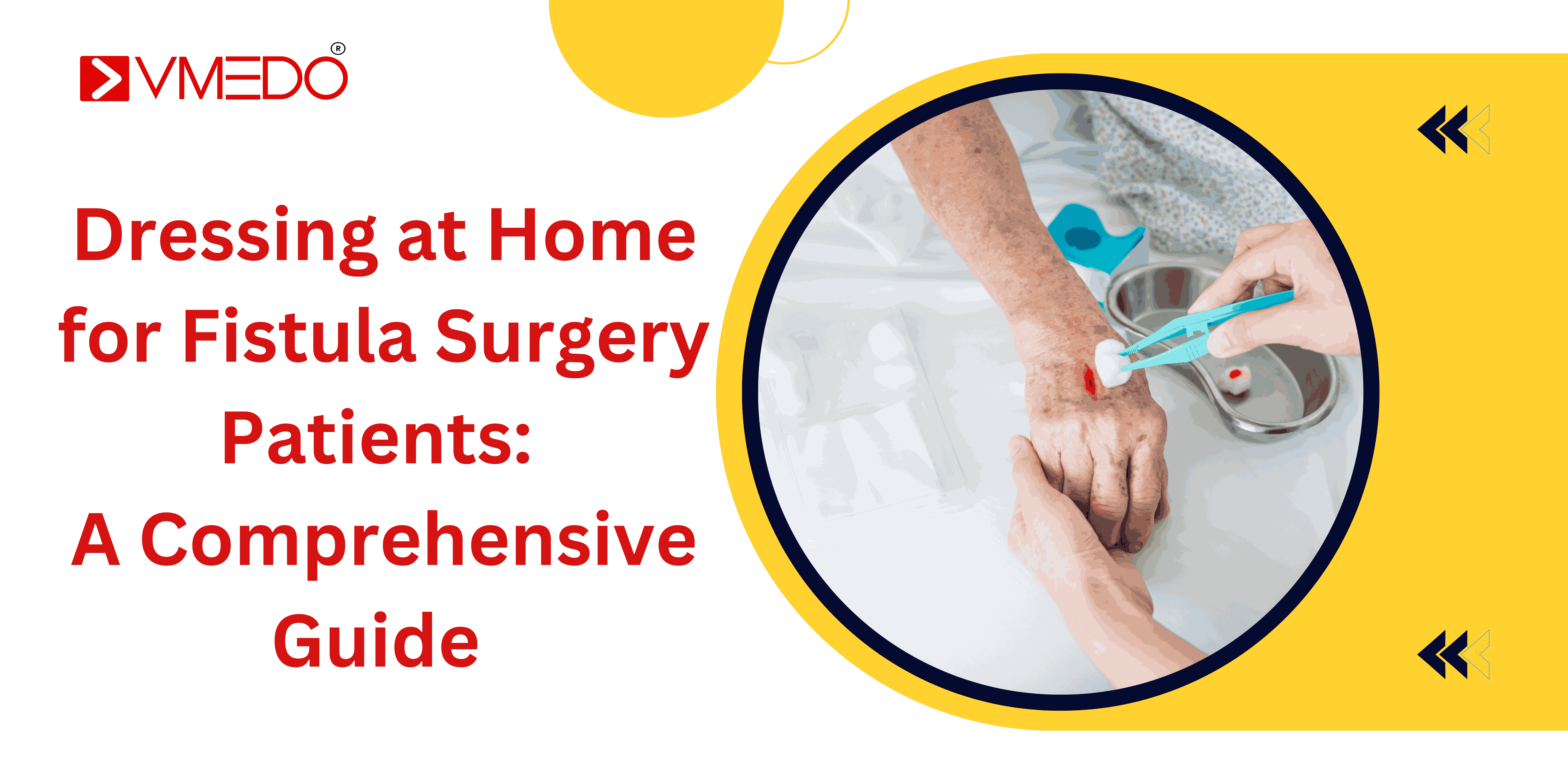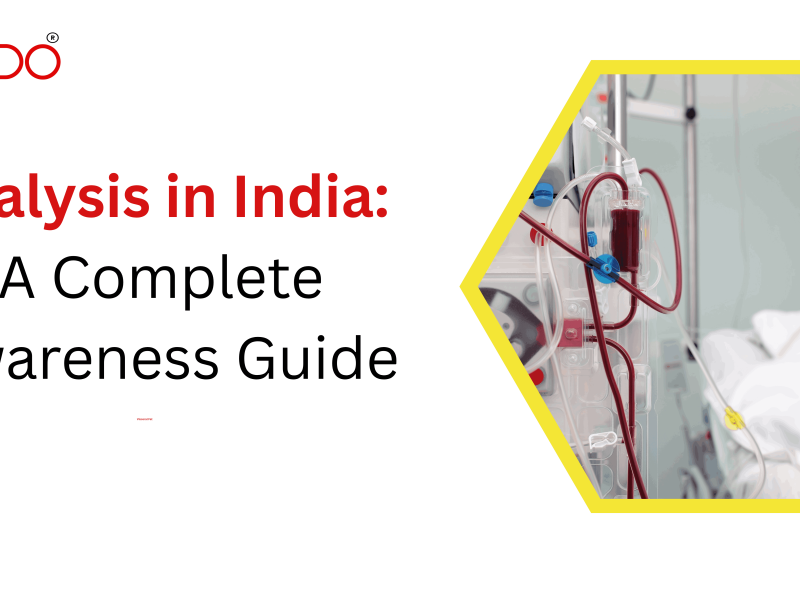Fistula surgery, while often necessary to treat the discomfort and complications associated with fistulas, requires careful post-operative care to ensure a successful recovery. Proper wound care and dressing are critical components of the healing process for fistula surgery patients. This guide provides detailed instructions on how to perform dressing changes at home, helping patients and caregivers manage post-operative care effectively and comfortably.
If you are looking for a Nurse at home for fistula wound dressing, then Look no further VMEDO mobile clinic is just around you, our highly experienced nurse will visit your home at your convenience and provide the dressing for fistula wound with the utmost hygiene and professionalism and help you recover fast. Contact VMEDO Helpline: 9343180000 for bookings.
However, if you want to do dressing on your own, we have explained the step-by-step dressing procedure to post-fistula surgery wounds. But first let’s understand what is Fistula surgery and the different surgery procedures.
Fistula Surgery: An Overview and Types of Procedures
Fistula surgery is a medical procedure designed to treat fistulas, which are abnormal connections between two body parts, such as organs or blood vessels. Fistulas can form due to injury, surgery, infection, or inflammation. They often require surgical intervention to prevent complications like infections or the spread of disease.
Fistulas can occur in various parts of the body, but the most common type is the anal fistula, which forms between the anal canal and the skin near the anus. Other types include gastrointestinal fistulas (e.g., between different parts of the intestine) and arteriovenous fistulas (abnormal connections between an artery and a vein).
What is Fistula Surgery?
Fistula surgery involves the surgical correction of these abnormal passages. The goals of fistula surgery are to:
- Close the fistula tract.
- Preserve normal function of the affected organs.
- Prevent recurrence of the fistula.
- Minimize damage to surrounding tissues.
The choice of procedure depends on the fistula’s location, complexity, and the patient’s overall health. Here is a detailed look at the various types of fistula procedures:
Types of Fistula Surgery Procedures
1. Fistulotomy
Description:
A fistulotomy is the most common procedure for simple anal fistulas. It involves cutting open the entire length of the fistula tract to allow it to heal from the inside out.
Procedure:
- The surgeon makes an incision along the fistula tract, which is then cleaned and left open to heal.
- This procedure is typically done under local or general anesthesia.
Advantages:
- High success rate for simple fistulas.
- Usually an outpatient procedure with quick recovery.
Disadvantages:
- Risk of incontinence if the fistula involves a significant portion of the anal sphincter muscle.
2. Seton Placement
Description:
A seton is a surgical thread placed within the fistula tract to keep it open and allow for drainage and healing over time.
Procedure:
- The seton is looped through the fistula tract and tied loosely or tightly depending on the type of seton used.
- The seton can remain in place for several weeks or months.
Advantages:
- Effective for complex or high fistulas that pass through sphincter muscles.
- Helps prevent abscess formation and allows for gradual healing.
Disadvantages:
- Requires multiple follow-up visits.
- Prolonged healing process compared to fistulotomy.
3. Advancement Flap Procedure
Description:
This procedure is used for more complex or recurrent fistulas. It involves covering the internal fistula opening with a flap of tissue from the rectum.
Procedure:
- The internal opening of the fistula is removed, and the surrounding tissue is used to create a flap.
- The flap is then sutured over the opening to close it.
Advantages:
- Preserves sphincter function.
- Suitable for fistulas that cannot be treated with fistulotomy.
Disadvantages:
- Higher risk of recurrence compared to fistulotomy.
- More complex procedure requiring skilled surgical expertise.
4. Ligation of Intersphincteric Fistula Tract (LIFT)
Description:
LIFT is a technique used for complex anal fistulas, particularly those that involve the sphincter muscles. It focuses on ligating (tying off) the fistula tract between the muscles.
Procedure:
- An incision is made in the intersphincteric groove (between the internal and external sphincter muscles).
- The fistula tract is identified, ligated, and then divided.
Advantages:
- Preserves sphincter integrity, reducing the risk of incontinence.
- Effective for high and complex fistulas.
Disadvantages:
- Requires specialized surgical skills.
- Possibility of fistula recurrence.
5. Fibrin Glue Injection
Description:
Fibrin glue is a biological adhesive used to close the fistula tract. It is a less invasive option compared to surgery.
Procedure:
- The fistula tract is cleaned and then filled with fibrin glue.
- The glue helps to seal the tract and promote tissue healing.
Advantages:
- Minimally invasive with no incisions required.
- Can be repeated if necessary.
Disadvantages:
- Lower success rate compared to surgical procedures.
- May not be suitable for complex fistulas.
6. Plug Insertion
Description:
A fistula plug is a bioabsorbable material inserted into the fistula tract to promote closure and healing.
Procedure:
- The plug is inserted into the tract and secured in place.
- Over time, the plug is absorbed by the body, and the fistula closes.
Advantages:
- Minimally invasive with reduced recovery time.
- Suitable for patients who prefer non-surgical options.
Disadvantages:
- Variable success rates.
- Potential for plug displacement or failure.
Proper wound care after fistula surgery is crucial for a successful recovery and to minimize the risk of complications. Fistula surgery, whether for anal fistulas or fistulas in other parts of the body, involves the creation of surgical wounds that require careful attention to heal effectively. Here’s a detailed look at the importance of proper wound care post-fistula surgery and key practices to follow:
Importance of Proper Wound Care Post-Fistula Surgery
1. Prevents Infection
- Risk Reduction: Surgical wounds are vulnerable to infection, especially in areas prone to bacteria, such as the anal region. Proper wound care helps keep the wound clean and reduces the risk of bacterial infections.
- Symptoms of Infection: Infections can cause symptoms such as increased pain, redness, swelling, pus, and fever. Preventing infection is crucial to avoid these complications.
2. Promotes Healing
- Accelerated Recovery: Proper wound care techniques can promote faster healing by ensuring that the wound remains clean, dry, and free from debris.
- Tissue Repair: Appropriate care helps maintain a moist environment that supports the body’s natural healing processes and tissue repair.
3. Reduces Pain and Discomfort
- Pain Management: Good wound care can reduce irritation and inflammation around the wound site, leading to less pain and discomfort for the patient.
- Comfort: Proper bandaging and wound management can prevent rubbing and friction, which can aggravate the wound and cause additional pain.
4. Minimizes Scarring
- Aesthetic Outcomes: Proper care can minimize scarring by ensuring that the wound heals evenly and without complications. This is especially important for fistulas located in visible areas.
- Functional Outcomes: Reducing scar tissue formation can also prevent complications related to mobility and function, particularly in areas with high movement.
5. Prevents Recurrence
- Avoiding Complications: Inadequate wound care can lead to complications such as abscess formation or the reopening of the fistula tract, increasing the risk of recurrence.
- Long-Term Success: Consistent and careful wound care helps ensure the long-term success of the surgical intervention, reducing the likelihood of needing additional surgeries.
6. Enhances Overall Recovery Experience
- Patient Well-Being: Patients who receive proper wound care are more likely to experience a smoother recovery with fewer complications and setbacks.
- Psychological Benefits: Knowing that their wound is healing properly can provide patients with peace of mind and reduce anxiety related to their recovery.
When performing wound care for a patient recovering from fistula surgery at home, having the right dressing supplies is crucial to ensure effective healing and minimize the risk of infection. Here’s a list of essential dressing supplies needed for fistula dressing:
Dressing Supplies Needed for Fistula Dressing
1. Sterile Gloves
- Purpose: Protects both the patient and the caregiver from infection. Ensures a sterile environment while handling the wound.
- Tip: Always use new sterile gloves for each dressing change to maintain hygiene.
2. Antiseptic Solution or Wipes
- Purpose: Cleans the wound area to prevent infection. Common antiseptics include iodine solution, hydrogen peroxide, or alcohol wipes.
- Tip: Use a mild antiseptic as recommended by a healthcare professional to avoid irritation.
3. Saline Solution
- Purpose: Rinse and clean the wound gently without irritating tissues. Maintains moisture balance in the wound area.
- Tip: The saline solution is isotonic, making it safe for cleaning sensitive areas.
4. Gauze Pads or Dressings
- Purpose: Absorb excess fluids and protect the wound from external contaminants. Gauze comes in various sizes and types (e.g., sterile, non-sterile).
- Tip: Use sterile gauze to cover the wound directly and prevent infection.
5. Non-Adherent Dressings
- Purpose: Prevents the dressing from sticking to the wound, reducing pain during dressing changes. Ideal for delicate or healing wounds.
- Tip: Non-adherent dressings are particularly useful for sensitive areas, as they minimize tissue damage.
6. Adhesive Tape or Dressing Retention Bandage
- Purpose: Secures the dressing in place, preventing movement or exposure. Choose hypoallergenic tape to reduce skin irritation.
- Tip: Use a flexible bandage that can accommodate body movements without causing discomfort.
7. Hydrocolloid or Foam Dressings
- Purpose: Provides a moist healing environment, which promotes faster healing. These dressings are excellent for absorbing fluids and preventing maceration.
- Tip: Hydrocolloid dressings are self-adhesive and waterproof, making them suitable for wounds with light to moderate exudate.
8. Wound Care Scissors
- Purpose: Cuts gauze, tape, and dressings to the appropriate size. Ensures a clean and precise cut to avoid frayed edges.
- Tip: Keep scissors clean and sterilized between uses to maintain hygiene.
9. Cotton Swabs or Applicators
- Purpose: Applies ointments, creams, or antiseptic solutions precisely. Helps in cleaning hard-to-reach areas.
- Tip: Use single-use swabs to prevent cross-contamination.
10. Wound Ointment or Cream
- Purpose: Promotes healing and prevents infection. Common options include antibiotic ointments or medicated creams as prescribed.
- Tip: Apply ointments sparingly and as directed by a healthcare provider.
11. Wound Measuring Tool
- Purpose: Measures the size and depth of the wound to monitor healing progress. Useful for tracking changes over time.
- Tip: A flexible ruler or disposable wound measurement guide can be used.
12. Disposal Bags
- Purpose: Safely dispose of used dressings, gloves, and other materials. Prevents the spread of bacteria and maintains cleanliness.
- Tip: Use biohazard bags for medical waste, if available.
13. Hand Sanitizer
- Purpose: Sanitizes hands before and after dressing changes to reduce the risk of contamination.
- Tip: Use an alcohol-based hand sanitizer with at least 60% alcohol content.
14. Moisturizer or Barrier Cream
- Purpose: Protects surrounding skin from irritation or breakdown caused by adhesives or exudate.
- Tip: Apply a thin layer to the skin around the wound, avoiding the wound itself.
Step-by-Step Fistula Wound Dressing Procedure
Step 1: Prepare the Area
- Clean the Space:
- Ensure the area where you’ll be changing the dressing is clean. Use a disinfectant wipe to clean surfaces if necessary.
- Gather Supplies:
- Lay out all the supplies within reach, ensuring everything is sterile.
- Wash Your Hands:
- Wash your hands thoroughly with soap and water. Dry with a clean towel or air dry.
- Put on Sterile Gloves:
- Wear gloves to prevent introducing bacteria to the wound site.
Step 2: Remove the Old Dressing
- Carefully Remove the Old Dressing:
- Gently peel away the old dressing, starting from the edges. If it sticks to the wound, moisten it with saline solution to ease removal.
- Dispose of the Old Dressing:
- Place the used dressing and gloves in a disposable plastic bag and seal it.
Step 3: Clean the Wound
- Assess the Wound:
- Check the wound for signs of infection, such as increased redness, swelling, or pus. If any signs are present, contact your healthcare provider.
- Clean the Wound:
- Use a sterile saline solution or wound cleanser to clean the wound gently. Start from the center and move outward to prevent contamination.
- Dry the Area:
- Pat the area dry with a sterile gauze pad, being careful not to irritate the wound.
Step 4: Apply New Dressing
- Apply Antiseptic Ointment:
- If prescribed, apply a thin layer of antiseptic ointment or medication to the wound.
- Place a New Gauze Pad:
- Cover the wound with a sterile gauze pad, ensuring it completely covers the area.
- Secure the Dressing:
- Use adhesive dressings or surgical tape to secure the gauze pad in place. Ensure it is snug but not too tight to allow airflow and comfort.
Step 5: Finalize
- Dispose of Waste:
- Safely dispose of all used materials in a sealed plastic bag.
- Clean Your Hands:
- Wash your hands thoroughly after completing the dressing change.
Caring for a fistula surgery wound at home requires diligence, patience, and adherence to medical advice. By following the steps outlined in this guide, you can effectively manage the dressing changes, promote healing, and ensure a smoother recovery process. Always consult with VMEDO doctors if you have any concerns or questions regarding your post-operative care. Remember, your well-being is the top priority, and taking these steps can help you return to your normal routine with confidence and health.



